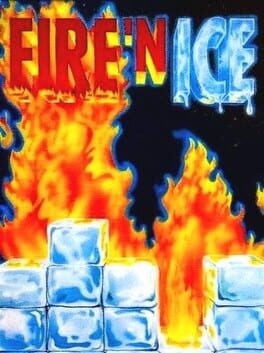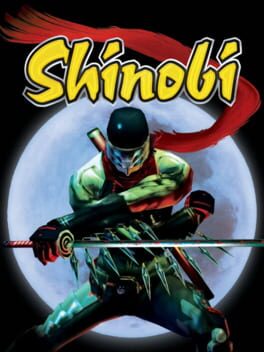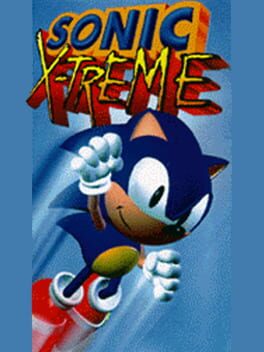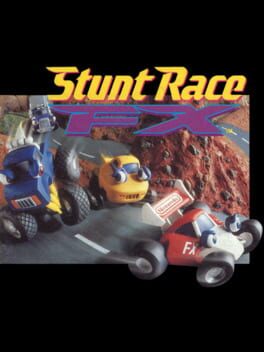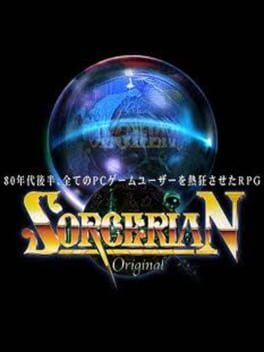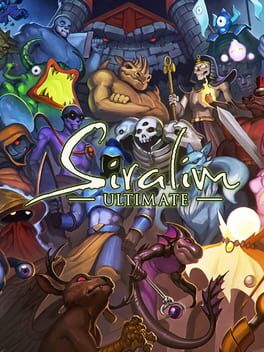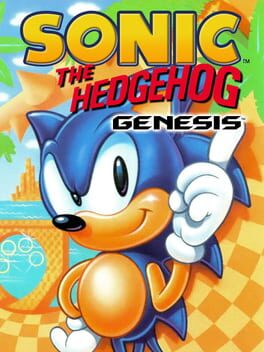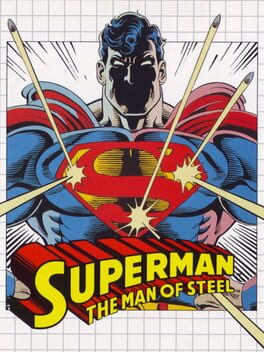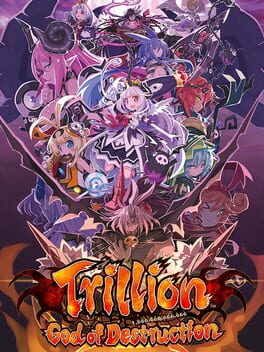LoreW001
186 Reviews liked by LoreW001
DJ Boy
1989
DJ Boy is a rather...archaic beatemup, to put it nicely. If you want to beat the tar out of racial caricatures and other gross stereotypes then this is for you. There's really nothing else of note even, it's just a very average game that happens to be very dated. Why do the first and last bosses have those big eyes and wide red lips? Where did that whole thing even come from? Have you never seen a black person before?
The Genesis version includes art at the end of levels, so you get to see the stark contast between a rather cutesy-looking DJ and a few of the aforementioned gross stereotypes (for example, https://pbs.twimg.com/media/FVAdECgWUAI34_s?format=png&name=900x900). It's very weird and unpleasant. Did people even laugh at this back then?
The Genesis version includes art at the end of levels, so you get to see the stark contast between a rather cutesy-looking DJ and a few of the aforementioned gross stereotypes (for example, https://pbs.twimg.com/media/FVAdECgWUAI34_s?format=png&name=900x900). It's very weird and unpleasant. Did people even laugh at this back then?
Fire 'n Ice
1992
a LOVELY puzzle game, oh wow. This game has changed my perspective on how good a NES game could be.
The devs found a simple mechanic (the ice wand) and never wavered from it. It allowed for so many clever puzzles with only one new twist every world or two. The way they introduced the mechanics was perfect, forcing you to run into the scenario that teaches you how a new piece of the puzzle works before sending you off to solve the rest of the world on your own. And you can skip around to any (non-boss) puzzle in ANY world, anytime you want! I can't believe how much this game got right, all the way back in 1992. Even the boss levels, with moving elements, were remarkably well-done, if somewhat repetitive.
Round 7-2 is perhaps one of the best puzzles in the whole game. Knowing it was possible, knowing there was no jank, made it so fun to figure out and so rewarding to get the solution.
The spritework is cute and awesome. The cutscenes and story were unexpected but welcome. There was a new song for each world and they were all bangers.
This game even has a level editor! I mean come on, this has to be one of the most impressive puzzle titles for the NES. What an absolute masterpiece.
The devs found a simple mechanic (the ice wand) and never wavered from it. It allowed for so many clever puzzles with only one new twist every world or two. The way they introduced the mechanics was perfect, forcing you to run into the scenario that teaches you how a new piece of the puzzle works before sending you off to solve the rest of the world on your own. And you can skip around to any (non-boss) puzzle in ANY world, anytime you want! I can't believe how much this game got right, all the way back in 1992. Even the boss levels, with moving elements, were remarkably well-done, if somewhat repetitive.
Round 7-2 is perhaps one of the best puzzles in the whole game. Knowing it was possible, knowing there was no jank, made it so fun to figure out and so rewarding to get the solution.
The spritework is cute and awesome. The cutscenes and story were unexpected but welcome. There was a new song for each world and they were all bangers.
This game even has a level editor! I mean come on, this has to be one of the most impressive puzzle titles for the NES. What an absolute masterpiece.
Fire 'n Ice
1992
Despite it's simplicity and age, Fire 'N Ice manages to really challenge your mind - or at least it challenged mine. While the first few worlds are easier, the difficulty quickly picks up, and each puzzle completed leaves you with a sense of achievement. A timeless classic that is an absolute must play for anyone who likes puzzle games.
Shinobi
2002
If you try and play Shinobi like a traditional hack-and-slash combo-heavy character action game, you'll probably find yourself getting frustrated within minutes. You can't dash or jump cancel sword swing animations, nor can you rotate your character's swings during the animation, so button mashing is discouraged and every attack matters that much more. Instead, the goal is to wrap up enemy encounters as quickly as possible, diving and dashing between foes to chain them together in a manner akin to abusing Sonic's homing attack (albeit with tougher execution). This is encouraged two-fold: firstly, Hotsuma's cursed sword requires sacrifices in the form of enemy blood (and running out of souls will cause the sword to sap his health instead), so slaying foes is in succession the most effective way to farm souls and satiate the sword's hunger. Just as importantly however, successfully chaining enemies builds up Hotsuma's damage output, so it becomes integral to prioritize weaker and clustered enemies so later hits can deal massive damage to bulkier foes; it's a great way to both highlight Shinobi's arcade puzzle-like qualities of efficiently navigating a room as well as giving the player a viable and clean strategy to quickly dispose of spongier enemies. This also applies towards boss fights, and there's nothing more satisfying than biding your time, waiting for the boss's goons to stack up, and then tearing your way through to finally slice the boss in one fell swoop.
To be fair, while a lot of Shinobi's criticism comes in the form of not understanding the above Tate system, there are other factors at play. I can admit that Shinobi doesn't feel very beginner friendly despite the seeming simplicity of its core concepts; there's no tutorial or in-game explanation of the game's mechanics, and if you don't understand basics like wall-running or stealth dashing behind foes to get around enemy stances (since side and back attacks deal more damage and some foes can block frontal strikes), you'll find yourself getting walled and wombo comboed by foes rather quickly due to what appears to be a lack of both invincibility frames and the game's inclination towards stun-heavy enemy attacks. Moreover, the game is definitely quite punishing: health drops can feel a bit scarce at times, jumps feel quite committal since you can't alter your aerial drift mid-jump and must rely on expending your double jump or dash, and falling off the stage will result in instant death with no midway checkpoints attached to any stage. That said, the biggest challenge for me was the rudimentary camera. It's fairly static, and as a result, it becomes a bit of a chore having to constantly rotate the camera mid-combat to spot all appearing foes so you don't have to attack while they're off-screen. The lock-on system makes it easier to target singular enemies at a time (and is often essential because there's no way to dash upwards/downwards towards foes without it), but it does present the additional issue of constantly needing to tilt the camera up and down afterwards: if the camera is pointed downwards, aerial enemies and floating collectibles are tough to spot, but if the camera is pointed upwards, then blind platforming becomes a nightmare. The other prevalent critique that comes to mind are the level designs themselves: while I don't have complaints towards enemy placements, I find that the level design motifs tend to bleed into one another within individual stages (i.e. specific platform and wall placements are repeated verbatim within the span of a few minutes), which can make the stages feel like they drag on too long, especially when no midway checkpoints exist. I also wish that there weren't so many straight corridors/tunnels present throughout the game, and could have done with more open room environments with wall-running opportunities. Finally, the final boss was unfortunately a miserable experience due to wonky mob hurtboxes (my sword kept phasing through and missing the spawned small-fry), the multitude of stun-heavy attacks from foes, and the element of luck involved (since the final boss loved to turn temporarily invulnerable or teleport away many instances after I had successfully chained the weaker minions for damage).
Even despite my criticisms however, I don't think Shinobi is anywhere as hard as a lot of players have made it out to be, and it is exactly what I had envisioned a ninja game to be: swift and efficient bread & butter combat that emphasized quick thinking and efficient traversal just as much as steady reflexes. It really never gets old slashing and dashing between scores of foes, and then cutting straight away to a cinematic of Hotsuma dramatically turning his blade while his prey is simultaneously sliced to shreds behind him. In conjunction, I certainly enjoyed the campy narrative regarding themes of light vs dark and revenge and honor between a bunch of folks who studied the blade. Lastly, the varied and fantastic soundtrack alongside the sleek visuals was the cherry on top to elevate those vibes. If you're willing to meet this game halfway despite all the classic 2000s PS2 jank and the intimidating learning curve, then I think you'll find a truly exhilarating experience that was ahead of its time in many ways despite the lack of polish, and a title that I think modern developers could learn a lot from.
To be fair, while a lot of Shinobi's criticism comes in the form of not understanding the above Tate system, there are other factors at play. I can admit that Shinobi doesn't feel very beginner friendly despite the seeming simplicity of its core concepts; there's no tutorial or in-game explanation of the game's mechanics, and if you don't understand basics like wall-running or stealth dashing behind foes to get around enemy stances (since side and back attacks deal more damage and some foes can block frontal strikes), you'll find yourself getting walled and wombo comboed by foes rather quickly due to what appears to be a lack of both invincibility frames and the game's inclination towards stun-heavy enemy attacks. Moreover, the game is definitely quite punishing: health drops can feel a bit scarce at times, jumps feel quite committal since you can't alter your aerial drift mid-jump and must rely on expending your double jump or dash, and falling off the stage will result in instant death with no midway checkpoints attached to any stage. That said, the biggest challenge for me was the rudimentary camera. It's fairly static, and as a result, it becomes a bit of a chore having to constantly rotate the camera mid-combat to spot all appearing foes so you don't have to attack while they're off-screen. The lock-on system makes it easier to target singular enemies at a time (and is often essential because there's no way to dash upwards/downwards towards foes without it), but it does present the additional issue of constantly needing to tilt the camera up and down afterwards: if the camera is pointed downwards, aerial enemies and floating collectibles are tough to spot, but if the camera is pointed upwards, then blind platforming becomes a nightmare. The other prevalent critique that comes to mind are the level designs themselves: while I don't have complaints towards enemy placements, I find that the level design motifs tend to bleed into one another within individual stages (i.e. specific platform and wall placements are repeated verbatim within the span of a few minutes), which can make the stages feel like they drag on too long, especially when no midway checkpoints exist. I also wish that there weren't so many straight corridors/tunnels present throughout the game, and could have done with more open room environments with wall-running opportunities. Finally, the final boss was unfortunately a miserable experience due to wonky mob hurtboxes (my sword kept phasing through and missing the spawned small-fry), the multitude of stun-heavy attacks from foes, and the element of luck involved (since the final boss loved to turn temporarily invulnerable or teleport away many instances after I had successfully chained the weaker minions for damage).
Even despite my criticisms however, I don't think Shinobi is anywhere as hard as a lot of players have made it out to be, and it is exactly what I had envisioned a ninja game to be: swift and efficient bread & butter combat that emphasized quick thinking and efficient traversal just as much as steady reflexes. It really never gets old slashing and dashing between scores of foes, and then cutting straight away to a cinematic of Hotsuma dramatically turning his blade while his prey is simultaneously sliced to shreds behind him. In conjunction, I certainly enjoyed the campy narrative regarding themes of light vs dark and revenge and honor between a bunch of folks who studied the blade. Lastly, the varied and fantastic soundtrack alongside the sleek visuals was the cherry on top to elevate those vibes. If you're willing to meet this game halfway despite all the classic 2000s PS2 jank and the intimidating learning curve, then I think you'll find a truly exhilarating experience that was ahead of its time in many ways despite the lack of polish, and a title that I think modern developers could learn a lot from.
Super Mario Bros.
1985
when you think about the fact that the true milestone of the whole gaming history till this day is a '80s classic 2d platformer about an italian plumber with a sexy mustache who somehow lives in a kingdom where almost everyone is an anthropomorphic mushroom (but you also eat mushrooms for power ups... cannibalism ?) except for his brother who in this game is just a color swapped version of mario and i dont even know if it was already established to call him luigi and a princess who later on will be called peach but now is just generically referred to as princess toadstool and if you follow the story (which was probably written in a dirty ass guide book since this game has 30 words in total i think) the kingdom is being invaded by other ??? mushroom ??? like ??? creatures or whatever and an army of walking turtles led by the hot and tempting king koopa aka daddy bowser who in this game is ugly as fuck and gets a third degree burn and kidnaps princess toadstool because sexism and because he wanted to fuck her or something i havent read the guide book anyway i was saying really makes you realise we live in a simulation
italians are so cool ♡ wish they were real
italians are so cool ♡ wish they were real
Super Mario Bros.
1985
Sonic X-treme
TBD
Stunt Race FX
1994
Wait... You mean to tell me THIS has secretly been the best SNES racing game all along?? I was put off by F-Zero and Super Mario Kart as a kid since the N64 versions were so much better, but if I had owned Stunt Race FX, I would have played the heck outta this. Forget about the framerate issues, they don't stop this from having superior and more intuitive handling than its peers, none of which look as charming as this adorable truck with its animated eyes and Rayman-esque limbless movements. If you can get past the choppiness, there is a KILLER racing game in here!
Stunt Race FX
1994
A cute little racing game made with that nifty super fx chip, but unfortunately time has not been kind to it.
The low poly look of this game in itself is appealing as usual for me, but what kills the game is the single-digit framerates it hits constantly. The framerate is actually so bad that it works against your controls and makes you feel like you're driving through molasses.
I had a good time with this game as a kid, but games like Burnout 3 Takedown and Wreckfest have spoiled me immensely. I for sure don't recommend it for the younger lads, at least as is......murmurs something about overclocking and retroarch and makes sure the nintendo cops don't beat the shit out of him
It'd be great if this game got a remake of sorts, preferably with the clay looking models of the cars from the box art. Unfortunately Nintendo gets irritable and goes into fits of old man rage at even the mention of F-Zero, let alone single entries they made back on the SNES.
Shame.
The low poly look of this game in itself is appealing as usual for me, but what kills the game is the single-digit framerates it hits constantly. The framerate is actually so bad that it works against your controls and makes you feel like you're driving through molasses.
I had a good time with this game as a kid, but games like Burnout 3 Takedown and Wreckfest have spoiled me immensely. I for sure don't recommend it for the younger lads, at least as is......murmurs something about overclocking and retroarch and makes sure the nintendo cops don't beat the shit out of him
It'd be great if this game got a remake of sorts, preferably with the clay looking models of the cars from the box art. Unfortunately Nintendo gets irritable and goes into fits of old man rage at even the mention of F-Zero, let alone single entries they made back on the SNES.
Shame.
Sorcerian Original
2000
After being astounded by the sheer SOUL that Ys I and II and Xanadu Next exuded, the Ribose gene inside me awakened and I craved more Falcom. One HG101 article later and I learn about Sorcerian Original, the 2000 remake an 80s 2D ARPG originally released on the PC-88, and the fifth installment in Falcom's seminal Dragon Slayer series. I saw a few screenshots, listened to few tracks, felt the pure SOUL course through my veins, and I knew I had to at least try it out. With the power of the Google translate app, no Japanese characters were gonna stop me.
The preparation phase of the game works just like Wizardry; you can go into town to create and organize a party of four with different sexes and races, buy equipment, appraise items and get magic, and train to raise stats or learn new skills. The magic system in particular is relatively fleshed out, as you can enchant equipment with "planets" to increase certain stats and allow you to use some of the surprisingly large amount of spells in the game. There's over a 100 you can mix and match, although you'll probably settle on a few mid-game, as the different offensive magic is by and large redundant, and experimenting is expensive and time-consuming.
The actual gameplay, on the other hand, controls kinda like Zelda II. You run and jump around exploring the dungeon, fighting enemies, and helping NPCs. Combat feels extremely haphazard; because enemy behavior is so erratic, damage is low, and your melee characters' ranges are extremely short, evasive manuevers are useless and fighting mobs (and bosses) quickly devolves into just running into them and staying on their ass while you spam everything. Dungeon exploration feels more deliberate, with branching paths, puzzles, secrets, loot, and backtracking. A TON of backtracking. EVERY quest had you going back and forth for whatever mandatory reason. It didn't bother me much, especially since you move so quickly, but it can be annoying since the game can get pretty obtuse. It's REALLY bad in some quests, like the murder mystery on the boat, which was made especially painful by the seemingly random triggers to progress.
While the assessment so far might seem pretty negative, I really did have fun with this game. Outside of the great, memorable soundtrack, Sorcerian excels at leveraging your imagination. The idea is similar to that of the earlier Wizardry or the later Etrian Odyssey; provide the player with a basic quest storyline and the tools to make a party, and let their imaginations run wild and fill the blanks. The simple fetch quest of the first mission can quickly establish archetypes and characterization for your blank slate party. Characters even age after quests and training, and can become middle and old-aged, and even die, leaving behind a successor, further encouraging players to write their own personal stories. The game even comes with a little handbook that fleshes out the backstory for quests and describes items and enemies, and a "Book of Magic" that describes what each spell does and how to make them. Makes me feel like an adventurer, reading notes and doing research before I embark on quests.
At the end of the day, although it's rudimentary and rough around the edges, I've never played a game before that so purely served as a vehicle for your own creativity. There really is great value in exploring Falcom's (and in turn, JRPGs') roots, and playing an untranslated late 90s Japanese Windows game feels so nostalgic. There's even demos for the future games Lord Monarch and Brandish VT on the disc. Hopefully one day they remake all of the expansion pack missions in this style, or at least release them in English.
The preparation phase of the game works just like Wizardry; you can go into town to create and organize a party of four with different sexes and races, buy equipment, appraise items and get magic, and train to raise stats or learn new skills. The magic system in particular is relatively fleshed out, as you can enchant equipment with "planets" to increase certain stats and allow you to use some of the surprisingly large amount of spells in the game. There's over a 100 you can mix and match, although you'll probably settle on a few mid-game, as the different offensive magic is by and large redundant, and experimenting is expensive and time-consuming.
The actual gameplay, on the other hand, controls kinda like Zelda II. You run and jump around exploring the dungeon, fighting enemies, and helping NPCs. Combat feels extremely haphazard; because enemy behavior is so erratic, damage is low, and your melee characters' ranges are extremely short, evasive manuevers are useless and fighting mobs (and bosses) quickly devolves into just running into them and staying on their ass while you spam everything. Dungeon exploration feels more deliberate, with branching paths, puzzles, secrets, loot, and backtracking. A TON of backtracking. EVERY quest had you going back and forth for whatever mandatory reason. It didn't bother me much, especially since you move so quickly, but it can be annoying since the game can get pretty obtuse. It's REALLY bad in some quests, like the murder mystery on the boat, which was made especially painful by the seemingly random triggers to progress.
While the assessment so far might seem pretty negative, I really did have fun with this game. Outside of the great, memorable soundtrack, Sorcerian excels at leveraging your imagination. The idea is similar to that of the earlier Wizardry or the later Etrian Odyssey; provide the player with a basic quest storyline and the tools to make a party, and let their imaginations run wild and fill the blanks. The simple fetch quest of the first mission can quickly establish archetypes and characterization for your blank slate party. Characters even age after quests and training, and can become middle and old-aged, and even die, leaving behind a successor, further encouraging players to write their own personal stories. The game even comes with a little handbook that fleshes out the backstory for quests and describes items and enemies, and a "Book of Magic" that describes what each spell does and how to make them. Makes me feel like an adventurer, reading notes and doing research before I embark on quests.
At the end of the day, although it's rudimentary and rough around the edges, I've never played a game before that so purely served as a vehicle for your own creativity. There really is great value in exploring Falcom's (and in turn, JRPGs') roots, and playing an untranslated late 90s Japanese Windows game feels so nostalgic. There's even demos for the future games Lord Monarch and Brandish VT on the disc. Hopefully one day they remake all of the expansion pack missions in this style, or at least release them in English.
Siralim Ultimate
2021
When I bought this game, I didn't have too much in the way of expectations. I thought I'd bounce off it pretty quickly...maybe even get a refund. Then I ended up buying this game for PC and Switch, and even gifted it to a friend. I don't regret any of those purchases in the slightest.
This game has quickly became one of my all-time favorites. Everything about this game has been meticulously and purposefully crafted. It knew exactly the type of experience it was going for and nailed it. I loved theorycrafting my team, putting it together, and watching as my effort paid off in the most satisfying way, and I sincerely look forward to playing more in the future, experimenting with different classes and playstyles, customizing my castle base, and going deep into the Realms.
This game has quickly became one of my all-time favorites. Everything about this game has been meticulously and purposefully crafted. It knew exactly the type of experience it was going for and nailed it. I loved theorycrafting my team, putting it together, and watching as my effort paid off in the most satisfying way, and I sincerely look forward to playing more in the future, experimenting with different classes and playstyles, customizing my castle base, and going deep into the Realms.
Dawn of Ys has to be my favorite classic Ys game, hands down. The story has its moments even if it’s not considered “canon” (since Memories of Celceta takes more inspiration from Mask of the Sun, the other Ys IV, instead of this one) and the voice-acting is a bit goofy and over-the-top (I won’t judge too harshly since I played with the English fan-dub), but the game is worth playing for the improved bump combat alone… certainly a sentence that I did not expect to say in my life. Take my opinion with a grain of salt here, since I’ve only played Ys I + II Chronicles, but I found the bump combat to be a bit inconsistent regarding its angle calculations in Ys I Chronicles + while Ys II Chronicles + significantly streamlined it, but made bump combat pretty free since I just needed to walk into enemies diagonally and corner them against walls. I find Dawn of Ys to hit a nice medium between these two extremes: walking diagonally into enemies will likely successfully damage opponents, but you can’t just walk and knock back enemies diagonally since they’ll get knocked horizontally/vertically instead. As a result, the optimal strategy is instead to carefully position yourself just off-center of the enemy’s character model center, and then walk into them horizontally/vertically, taking care not to run into walls because Dawn of Ys has no invincibility frames and squeezing enemies into walls will cause Adol to contact their center and take tons of damage. All the while, enemies are constantly repositioning themselves and trying to maneuver around you so they can strike you with their center, making Dawn of Ys’s bump combat a more intricate spacing game of you + enemies trying to correctly run at each other. It’s certainly a much more engaging way to pass the time while grinding for levels to scale up to bosses, since single levels make a huge difference for stat gains to increase your margin of error. Regardless, thanks to a few late game abilities/items such as the Timer Ring (to slow down enemies) and the Solomon Shoes (instakilling foes in exchange for slowing your movement) that make bump combat quicker (but not necessarily mindless due to better AI pathing and lack of cornering) alongside instant enemy respawns once their spawn position is off-screen, I found grinding to be a lot more enjoyable this time around.
I find myself with very few complaints this time around, mainly because Dawn of Ys strikes a nice balance in taking what I like from Ys I and what I like from Ys II, and often improving upon that to boot. There’s a good mix of magic focused bullet-hell shmup-esque fights resembling those of Ys II and more bump-combat heavy fights resembling those of Ys I, and none of them felt unfair: good positioning and quick hazard awareness go pretty far, and you can usually spot enemy attacks and patterns soon enough to successfully dodge practically every attack if you space correctly. Dungeon designs are again, a good balance between straight linear tunnels and sprawling labyrinths; the best dungeons are never pure straight-shots, but also don’t waste your time with excess empty & isolated rooms so you can quickly figure out the correct path and get back on track. The adventure game elements of figuring what to collect and where to use corresponding key items often made the first two Ys games a bit esoteric without a guide, but I find that to not be the case at all here: tells are pretty evident, with tons of context clues dictated by environmental features + nearby NPC dialogue, and the overworld unlocks pretty naturally with backtracking very heavily stressed when necessary (and is fairly quick thanks to warp magic). I’ve heard complaints that Dawn of Ys is a bit long too, but if you compare the total run-time to Ys I and Ys II combined (since they’re essentially two parts of a bigger product meant to be played back to back), then it’s not too bad (10-14 hours for Dawn of Ys compared to 14-17 hours for Ys I + II Chronicles according to howlongtobeat) as long as you don’t spend too much time bumbling about and minimizing downtime from healing + excess grinding with the right strategies.
My only prevalent gripe is that I found the game to be a bit on the easy side (an opinion which I think I’m in the minority for), particularly regarding the last couple of hours. A few of the endgame bosses can be somewhat cheesed with Power Ring + Shield Magic to chip away most/all of their health bar, the final dungeon is extremely short (just a line of singular tunnels that take less than five minutes to run through), and I personally found the final boss to be a letdown: the final phase is a joke once you figure out the obvious blind spots, and I ended up winning on my first try even though it’s always taken me multiple tries to clear the final boss in the other Ys games. In addition, you get a lot of leeway with the Herb + Elixir providing two possible full health restores for most fights, so it tends to be a pretty forgiving game. If I really had to nitpick further, I’d also say that money tends to feel superfluous considering how few items there were to purchase compared to how much money I gained from slaying monsters; Hudson probably could have done away with money in the game entirely and just focused on locking items behind necessary dungeon treasure chests and NPCs as part of progression.
Aside from that, I found Dawn of Ys to be a really pleasant experience. The spritework + animated cutscenes still hold up pretty well, the soundtrack continues to kick major ass because Falcom Sound Team JDK have phenomenal composition embedded in their blood, and the side characters and villains get really great screentime in comparison to Ys I + II (where the villains are mostly in the background doing mysterious shadowy things). I’m gonna miss Dogi when I get back around to running through Memories of Celceta, that’s for sure. All in all, I’m a little surprised by how much I ended up enjoying this considering my more qualified praise regarding the remakes of the originals, and I definitely think it’s worth going out of your way for if you’re a hardcore Ys fan and enjoy the quick bump combat of classic Ys.
I find myself with very few complaints this time around, mainly because Dawn of Ys strikes a nice balance in taking what I like from Ys I and what I like from Ys II, and often improving upon that to boot. There’s a good mix of magic focused bullet-hell shmup-esque fights resembling those of Ys II and more bump-combat heavy fights resembling those of Ys I, and none of them felt unfair: good positioning and quick hazard awareness go pretty far, and you can usually spot enemy attacks and patterns soon enough to successfully dodge practically every attack if you space correctly. Dungeon designs are again, a good balance between straight linear tunnels and sprawling labyrinths; the best dungeons are never pure straight-shots, but also don’t waste your time with excess empty & isolated rooms so you can quickly figure out the correct path and get back on track. The adventure game elements of figuring what to collect and where to use corresponding key items often made the first two Ys games a bit esoteric without a guide, but I find that to not be the case at all here: tells are pretty evident, with tons of context clues dictated by environmental features + nearby NPC dialogue, and the overworld unlocks pretty naturally with backtracking very heavily stressed when necessary (and is fairly quick thanks to warp magic). I’ve heard complaints that Dawn of Ys is a bit long too, but if you compare the total run-time to Ys I and Ys II combined (since they’re essentially two parts of a bigger product meant to be played back to back), then it’s not too bad (10-14 hours for Dawn of Ys compared to 14-17 hours for Ys I + II Chronicles according to howlongtobeat) as long as you don’t spend too much time bumbling about and minimizing downtime from healing + excess grinding with the right strategies.
My only prevalent gripe is that I found the game to be a bit on the easy side (an opinion which I think I’m in the minority for), particularly regarding the last couple of hours. A few of the endgame bosses can be somewhat cheesed with Power Ring + Shield Magic to chip away most/all of their health bar, the final dungeon is extremely short (just a line of singular tunnels that take less than five minutes to run through), and I personally found the final boss to be a letdown: the final phase is a joke once you figure out the obvious blind spots, and I ended up winning on my first try even though it’s always taken me multiple tries to clear the final boss in the other Ys games. In addition, you get a lot of leeway with the Herb + Elixir providing two possible full health restores for most fights, so it tends to be a pretty forgiving game. If I really had to nitpick further, I’d also say that money tends to feel superfluous considering how few items there were to purchase compared to how much money I gained from slaying monsters; Hudson probably could have done away with money in the game entirely and just focused on locking items behind necessary dungeon treasure chests and NPCs as part of progression.
Aside from that, I found Dawn of Ys to be a really pleasant experience. The spritework + animated cutscenes still hold up pretty well, the soundtrack continues to kick major ass because Falcom Sound Team JDK have phenomenal composition embedded in their blood, and the side characters and villains get really great screentime in comparison to Ys I + II (where the villains are mostly in the background doing mysterious shadowy things). I’m gonna miss Dogi when I get back around to running through Memories of Celceta, that’s for sure. All in all, I’m a little surprised by how much I ended up enjoying this considering my more qualified praise regarding the remakes of the originals, and I definitely think it’s worth going out of your way for if you’re a hardcore Ys fan and enjoy the quick bump combat of classic Ys.
Trillion is what I would consider to be "double-niche", as it is a mish-mash of (mainly) two genres: SRPG and Raising Simulator. About 80% of this game is navigating menus and reading the VN-style cutscenes as you train and raise Affection with the Overlord of your choosing (at least for the first 3, the rest after that are in a set order). The other 20% is mystery-dungeon-like gameplay where you navigate on a grid through the Valley of Swords for training or to fight Trillion; anytime YOU move, the enemies will make a move of some sort as well, each move you make being a "turn."
For your very first run, I'd STRONGLY encourage you to forego any sort of guides and just do it blindly and take your best whack at Trillion that you can, because while there are various ways to go about defeating him, there's a pretty easy way to do it that will suck all the fun out of trying all sort of different playstyles. I had originally played this on the PSVita and, after my first run or so, could no longer play it due to it crashing all the time. I picked it up again on Steam and I'm pretty glad I did. In addition to the bugs from the Vita version being next-to-non-existent, I thoroughly enjoyed the story and getting the 10 different endings. There's plenty of everything to go around here: comedic relief bits, fanservice, and heart-wrenching despair as you watch the Overlord, that you trained and who fell in love with you, get eaten like yesterday's leftover potato casserole. If you have the fortitude and willpower for grinding, there's a nice bit to be appreciated by 100%-ing this. That being said, if you just picked this up for cheap on a Steam sale, I'd say just play two or three runs, making your final run the True Ending run for good measure so you get the closure you, and anyone else playing this, would deserve.
An interesting fact about this game is that while it was developed by Compile Heart, quite a few Disgaea staffers were on board with the project, such as the director of Disgaea 4, Masahiro Yamamoto, and the composer for Phantom Brave and Disgaea: Hour of Darkness, Tenpei Sato. Sato's signature style is very present here, as just like in Disgaea, you'll find yourself humming the tracks that play in the menus, when fighting Trillion, etc. even long after you've been done playing the game.
I very rarely 100% games. I've only ever 100%'d three games in my life, but this one was worth it to me. Getting to see each Overlord's ending, and watch them die again and again and again and again all for the climax in the true final chapter was all-too satisfying.
(I hope you'll allow it, but I simply copy-pasted the review I had already written for this game on Steam)
For your very first run, I'd STRONGLY encourage you to forego any sort of guides and just do it blindly and take your best whack at Trillion that you can, because while there are various ways to go about defeating him, there's a pretty easy way to do it that will suck all the fun out of trying all sort of different playstyles. I had originally played this on the PSVita and, after my first run or so, could no longer play it due to it crashing all the time. I picked it up again on Steam and I'm pretty glad I did. In addition to the bugs from the Vita version being next-to-non-existent, I thoroughly enjoyed the story and getting the 10 different endings. There's plenty of everything to go around here: comedic relief bits, fanservice, and heart-wrenching despair as you watch the Overlord, that you trained and who fell in love with you, get eaten like yesterday's leftover potato casserole. If you have the fortitude and willpower for grinding, there's a nice bit to be appreciated by 100%-ing this. That being said, if you just picked this up for cheap on a Steam sale, I'd say just play two or three runs, making your final run the True Ending run for good measure so you get the closure you, and anyone else playing this, would deserve.
An interesting fact about this game is that while it was developed by Compile Heart, quite a few Disgaea staffers were on board with the project, such as the director of Disgaea 4, Masahiro Yamamoto, and the composer for Phantom Brave and Disgaea: Hour of Darkness, Tenpei Sato. Sato's signature style is very present here, as just like in Disgaea, you'll find yourself humming the tracks that play in the menus, when fighting Trillion, etc. even long after you've been done playing the game.
I very rarely 100% games. I've only ever 100%'d three games in my life, but this one was worth it to me. Getting to see each Overlord's ending, and watch them die again and again and again and again all for the climax in the true final chapter was all-too satisfying.
(I hope you'll allow it, but I simply copy-pasted the review I had already written for this game on Steam)

